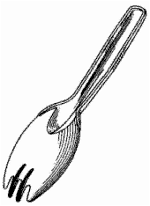 A 1998 design patent drawing for a spork, from U.S. Patent D388,664
A 1998 design patent drawing for a spork, from U.S. Patent D388,664The fork. Such a simple, easy-to-use tool, considered indispensable but becoming obsolete as the fast-food industry changes the way we eat. But…where did the fork come from and how did this eating instrument come into common use? Off to Google-land I went.
The two-prong twig was perhaps the first fork. The word fork comes from the Latin furca, meaning "pitchfork." Some of the earliest known uses of forks with food occurred in Ancient Egypt where large forks were used as cooking utensils. The ancient Greeks used the fork as a serving utensil, and it is also mentioned in the Hebrew Bible, in the Book of I Samuel 2:13.
Most diners ate with their fingers and a knife, which they brought with them to the table. The personal table fork was most likely invented in the Eastern Roman, or Byzantine, Empire where they were in common use by the 4th century CE.
Europe did not adopt use of the fork until the 18th century. Its use was first described in English by Thomas Coryat in a volume of writings on his Italian travels (1611), but for many years it was viewed as an unmanly Italian affectation. The English ridiculed forks as being effeminate and unnecessary.
Some writers of the Roman Catholic Church expressly disapproved of its use (despite its above-mentioned use in the Bible), seeing it as "excessive delicacy": "God in his wisdom has provided man with natural forks – his fingers. Therefore it is an insult to Him to substitute artificial metallic forks for them when eating
Forks came to be adopted by the wealthy. They were prized possessions made of expensive materials intended to impress guests. In late 17th Century France, larger forks with four curved tines were developed. The additional tines made diners less likely to drop food, and the curved tines served as a scoop. Forks made before 1600 with as many as five tines still exist today.
The 20th century saw the emergence of the "spork", a utensil that is half-fork and half-spoon. The spork was trademarked in the 1969 but probably has been around for at least a century. With this new "fork-spoon", only one piece of cutlery is needed when eating (so long as no knife is required.)
Wikipedia lists and describes over 32 forks for different purposes., if you're interested.
I want to thank Chad Ward, author of An Edge in the Kitchen, for the additional information he provided.

Very cool. Have to say, I don't really care for the spork. Though I do like the word. :-)
ReplyDelete"Some writers of the Roman Catholic Church expressly disapproved of its use (despite its above-mentioned use in the Bible), seeing it as "excessive delicacy""
ReplyDeleteInteresting!
Oh, and this brought back memories of sitting around the campfire one night and arguing with my friends about how many tongs a spork had.
We finally had to google it.
Some pages said 3 and some said 4.
Now we are always sending each other pictures of sporks we find with the amount we each had guessed.
3 is more common so most importantly, I'm correct! :)
Aha! Now I remember what a spork is! Terrific bit of historical trivia, Gay. Thanks for directing me over here.
ReplyDelete